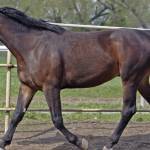What Are the Effects of Diet and Exercise on Stored Energy in Horses?

Two experiments were conducted to determine the effect of exercise and diet on muscle and liver glycogen repletion in horses.
In the first experiment, four Standardbred horses were fed either a high-carbohydrate or high-fat diet in a two-period switchback pattern. During the first 12 days of each period, the horses were fed their diets along with timothy hay and were allowed to exercise in small paddocks. The next phase was six days of exercise on a treadmill for increasing periods of time, with feed amounts rising as exercise increased. Muscle and liver biopsies were taken before and after the exercise phase.
In the second experiment, three Standardbred horses were fed separate diets high in either carbohydrate, fat, or protein. Muscle biopsies were taken before and immediately after a strenuous bout of exercise. The horses were then allowed to rest for 7 to 10 days in stalls with some free exercise in small paddocks, after which muscle biopsies were again taken.
In the first experiment, there was a 20% decrease in glycogen stores, and muscle glycogen concentration tended to be slightly lower than pre-resting values even after three days of rest with both diets. Liver glycogen was fully restored in both treatments. In the second experiment, horses on the high-carbohydrate diet had muscle glycogen depleted by 29% by a strenuous exercise bout and then increased to 122% of the pre-exercised values.
This report of research conducted in 1987 by Joe D. Pagan and coworkers was published in Proceedings of the 10th Equine Nutrition and Physiology Society Symposium.
Read the entire research paper, titled The Effect of Exercise and Diet on Muscle and Liver Glycogen Repletion in Standardbred Horses.








